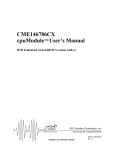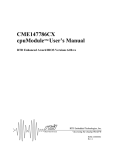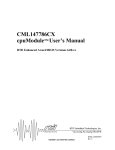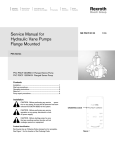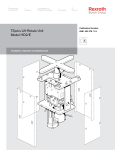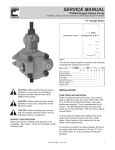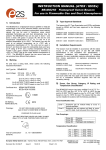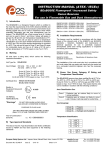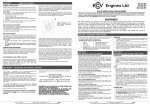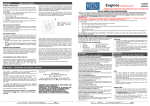Download Service Manual for Hydraulic Vane Pumps
Transcript
Industrial Hydraulics Electric Drives and Controls Linear Motion and Assembly Technologies Pneumatics Service Automation Mobile Hydraulics SM PSSF/07.03 Service Manual for Hydraulic Vane Pumps Subplate Mounted 1/06 PVC Series PVC PSSF 09ERM-01 Series Pump Contents Installation ................................................................................................. 1 Start-up procedures ................................................................................ 2 Operating instructions ............................................................................ 2 Parts list ..................................................................................................... 3 Pump repair procedures ........................................................................ 4 Installation CAUTION – Before performing any service operation on any Vane Pump, be sure that all pressure has been relieved from BOTH SIDES of the system. CAUTION – Before performing any service operation on any Vane Pump, disconnect or lock off power supply. CAUTION – Before manually actuating any Vane Pump, be sure that any resulting machine function will not endanger persons or equipment. Pump and drive mounting When mounting the pump and motor, care must be taken to align the pump and motor shafts within .003 T.I.R. Direct inline drive through a jaw type/flexible web coupling is recommended for all Rexroth pumps. Tire-type flexing elements and chain-type are not recommended. With belt drives, please consult factory. To avoid axial and radial end loading of the pump shaft do not couple the pump and motor shafts rigidly. Allow freedom at the coupling for the two shafts to ride independently. To prevent end loading the space between the pump and motor shaft ends should be 1/2 inch for PVC pumps, or as the coupling manufacturer specifies. Piping and reservoir The pump should be mounted on the reservoir, such that there will be a minimum number of elbows or fittings. The pump suction should be at least 1-inch tube/pipe. For any system and combination of piping, the vacuum at the pump inlet must not exceed 7 inches of mercury, (5" Hg. for fire resistant fluids). Piping should be done with pickled pipe or seamless tubing free of dirt and scale. Do not use galvanized or other pipe that tends to flake off. A 100-mesh screen should be used on the pump suction line. The screen should be located approximately 2" from the bottom of the tank. All lines returning oil to the tank should discharge at least 2" below the minimum oil level and should be separated from the pump suction area by means of a baffle. These lines should also include a 10-micron return line filter with the exception of the case drain line. 2/06 Bosch Rexroth Corp. Industrial Hydraulics Service Manual SM PSSF/07.03 The pump case drain should be connected directly to the tank. Pressure in excess of 10 psi in the case drain line can result in shaft seal leakage. It is recommended that the case drain be returned to the tank by a separate 3/8" line. Operating procedures Start-up procedures All pumps (except those with special volume or pressure requirements) are adjusted to reduced pressure before shipment and must be readjusted to the required system pressure after installation and start-up. The following instructions apply for initial start-up of the hydraulic pump. After an extended shutdown period, start with Item 5. 1. Check the nameplate and model number for rpm. Direction of rotation is indicated by the arrow on the pump casting. 2. Pump suction line should extend below the lowest point of oil level but not less than two inches above reservoir bottom. 3. The pump and motor shafts must be aligned within .003 inches. (For Restrictions see Pump Drive and Mounting directions above). 4. Connect the case drain directly to tank (or to a heat exchanger if pump will be dead-heading for long periods of time during operation), using a full-size line corresponding to the case drain port in the pump or manifold. If connected to a heat exchanger, the case drain line should be protected with an 8 psi maximum relief valve in parallel with the heat exchanger. No other return lines should be connected in common with the case drain return. 5. Rotate pump and motor by hand to insure free rotation. 6. Set the machine controls to open the circuit and allow free flow from the pump back to tank, or connect the pump outlet line directly to tank. Jog the motor on and off several times (on, two seconds -- off, three seconds) until the pump is primed. Check pump for proper direction of rotation during the jogging. NEVER START A NEW PUMP INSTALLATION AGAINST A BLOCKED SYSTEM. 7. After the pump has been primed, run it for several minutes at lower than normal pressures with an open or intermittently open system, which permits oil flow. This will purge entrapped air from the pump and system. 8. Neither volume adjustment nor pressure adjustment should be adjusted until the pump has been primed and running and the air is purged. Pressure and volume adjustments Pressure control The pressure adjusting screw is located at the end face of the compensator chamber. See Parts Page, Item No. 30. The adjusting screw has a right hand thread; clockwise adjustment of the screw will increase pressure; counterclockwise adjustment will reduce pressure. A pressure gage located at the pump must be used when making adjustments to insure the pressure settings do not exceed limits specified for the particular pump or maximum system pressure. Make all pressure settings with pump operating against a closed circuit, that is, with the output of the pump blocked. Then check pressures throughout the pump flow range. Volume control Adjust volume at minimum pump pressure or at pump deadhead. The adjusting screw has a right hand thread; turning the screw clockwise decreases the maximum volume, turning the screw counterclockwise increases the maximum volume. Pumps are set at maximum rated volume at the factory unless otherwise specified. Stop adjustment at the volume screw when pressure begins to drop. Adjustment procedures CAUTION:Turning the maximum volume control in too far can force the cam ring over center 1. `Set pump at minimum pressure. 2. `Hand tighten the volume screw until it touches the cam ring. NOTE: The pump should be at full flow for this step. 9. After air has been purged from the system, the system can be closed and the pump adjusted to the required operating pressure. 3. `See Pressure & Volume Adjustment Sensitivity Chart. 10. If required, the volume adjustment can be adjusted to limit maximum output to the desired amount. 5. `Return pump to flow condition & check flow rate. If output flow is incorrect, switch pump to deadhead and readjust per above. 11. If it becomes necessary to replace pumps, the suction screen in the reservoir should be removed and thoroughly cleaned. Also, the suction line from the reservoir to the pump should be flushed inside and out to remove any contaminants. Pieces of metal from a damaged pump can back up into this line. If they are not removed. they will be drawn into the new pump and destroy it. Start unit by using proper pump start-up procedures as previously stated. Pressure and volume adjustment sensitivity CAUTION: If both pressure and volume options are supplied on the pump, the pressure should be adjusted before the volume. Volume should be adjusted at minimum pump pressure or at deadhead. Stop adjustment at the volume screw when pressure begins to drop. 4. `Deadhead the pump; turn in the volume screw the proper number of turns to obtain the flow desired. Pump Size Pressure Code Pressure Adjustment Volume Adjustment Pressure change/turn Maximum torque PVC PSSF 09 E = 1000 psi psi (bar) 240 (16.6) ft-lbs (kg-M) 4.0 (0.55) Flow change/turn gpm (lpm) 4.6 (17.4) Approx. min. flow adj. gpm (lpm) 1.25 (4.7) ft-lbs (kg-M) 1.0 (0.14) Maximum torque SM PSSF/07.03 Service Manual Industrial Hydraulics Parts list* Bosch Rexroth Corp. 3/06 95 24 21 21 38 33 19 9 30 8 10 22 3 7 5 13 21 17 2 23 11 39 39 16 18 4 6 66 67 *Parts shown for reference only, not available for individual sale. ITEM NO. CODE 1 Pump Body 1 2 Cover 1 3 Rotor Shaft 1 4 Port Plate 5 6 BB 7 BB 8 80 NO. REQ. DESCRIPTION Thrust Plate 1 Pressure Ring 1 17 ITEM NO. CODE Viton Vane Kit 1 Spring Seat 1 30 30 NO. REQ. DESCRIPTION Pressure Adj. Screw Pressure Adj. Screw 1 1 9 8BlO Governor Spring 1 33 Jam Nut 1 10 8 Follower Spring 1 O-Ring O-Ring 1 1 11 Ring Shoe Assembly 1 37 37 13 Teflon Seal Ring 1 38 Volume Screw 1 15 15 Viton O-Ring O-Ring 1 1 39 39 O-Ring O-Ring 2 2 16 16 O-Ring O-Ring 1 1 40 Straight THD Plug 1 Viton 45 PMA-1536 1 1 1 54 PMA-1536 1 Viton O-Ring O-Ring 55 PMA-6A 1 Socket Hd. Cap Screw 4 58 Mounting Plate (Not Shown) 1 17 17 18 Viton Viton 19 Thrust Screw 1 21 Bushing Bearing 2 66 Escutcheon 1 22 Key 1 67 Drive Screw 4 23 Roll Pin 2 80 Dowel Pin 2 24 Lip Seal 1 95 Thrust Screw Plug Kit 1 Repair parts kits Complete rebuild kits Viton seal kit Includes items: 13, 15,16, 17, 24, 30, 37, 39, 55 & 99 Kit No. R978715450 Includes items: 3, 4, 5, 6, 7, 21 and Seal kit Kit No. R978715453 4/06 Bosch Rexroth Corp. Industrial Hydraulics Service Manual SM PSSF/07.03 Pump repair procedures NOTE: A pump that has been disassembled for changing components or for any other reason may void the warranty. Disassembly procedure CAUTION: Disconnect or lock out all power before disassembly. Ressembly procedure 1. The parts should be cleaned and inspected to determine which parts are worn enough to require replacement. 1. Remove the key (22) in the rotor shaft keyway. 2. Check all of the replacement parts for nicks or burrs and then lubricate them with clean oil before re-assembly. 2. Remove the 4 cover bolts and slide the cover back far enough on the shaft to break the seal between the housing and cover to allow the pump to drain. 3. Worn port and thrust plates should not be re-ground to clean up the wear surface. 3. Remove the cover, care must be taken not to damage the bearing with the end of the shaft when the cover is removed. 4. The thrust plate (5) may come out with the cover so care must be taken not to let it drop off the locating pins. 5. Remove the vanes (7) with a long nosed pliers or tweezers. There is 1 vane in each slot, 13 vanes total. 6. Remove the rotor shaft (3) from the pump. Be sure that the key (22) has been removed from the keyway so that it will not damage the shaft seals when the rotor shaft is removed. 7. Turn the pressure adjustment screw (30) counterclockwise to release the tension on the governor spring. If the plates are ground, the assembly clearance will become excessive and the seal rings in the thrust plate may rupture. 4. Assemble the new bearings in the housing and cover. The bearing O.D.'s should be lubricated before they are pressed into the bores. Care must be taken to orient the "split" and the "oil groove" in the bearing as shown in the illustration on the right. 5. After the bearings are in place, check to see that the rotor shaft will fit into the bearings and provide a smooth turning fit. If the shaft turns hard, the bearings should be replaced and the bore should be checked closely for nicks or burrs before pressing in the new bearings. 6. Assemble the springs and spring shoe, ring and rotorcraft. 8. Remove the cam ring (6), spring shoe (ll), governor spring (9), retainer, and follow-up spring (10). 7. Assemble the vanes with the beveled edge out against the cam ring. 9. If the shaft seals (24) are to be removed they should be pushed out from the inside of the housing at this time. Care must be taken not to damage the journal bearing in the housing, while the shaft seals are being removed. It is recommended that the shaft seals be replaced whenever the pump is disassembled for maintenance. The seals should not be re-used once they have been removed. 8. Assemble the square seal rings into the cavity in the back of the thrust plate. The soft rubber seal rings should be assembled first and the hard seal rings should be assembled on the top of them. Stretch the larger soft seal ring slightly .So it clings to the O.D. of the cavity. Apply clean oil or STP to the back of the thrust disc before It is placed on the locating pins in the cover so It will help to hold the parts together while they are assembled. 10. The journal bearing (21) in the pumps are assembled with a press fit. If they are to be replaced they may be removed at this time. The bearing in the housing should be pressed out from the front. The cover bearing should be pulled out using an expanding type puller. The bearings should not be re-used once they have been removed. 9. Before fitting the cover into the housing, check to assure that the bore in the port plate is concentric to the bearing bore in the body. If the bores are not concentric, the port plate must be relocated 1800 on the locating pins. 11. It is unlikely that further disassembly will be necessary in order to perform routine maintenance on the pump. 10. Assemble the cover and plate onto the body housing and align the boltholes. Rotate the shaft as the bolts are tightened to assure that the vanes are not cocked. 11. Torque the cover bolts to 50 lbs./ft. ± 10 lbs./ft. The shaft should turn by hand when assembly is complete. 12. Lubricate the I.D. of the two shaft seals and press them in to the depth shown in the illustration. Note the "both lips to the inside" orientation of the seals. 13. Adjust the pressure adjustment screw until it just touches the spring and then give it one more turn clockwise. 14. Turn pump upside down. Pour one cup of good grade hydraulic fluid into the intake port while slowly rotating the shaft in the direction shown by the rotation arrow. 15. The pump is now ready to test. Refer to front of this manual for start-up procedure. SM PSSF/07.03 Service Manual Industrial Hydraulics Bosch Rexroth Corp. Pump repair procedures (continued) NOTE: A pump that has been disassembled for changing components or for any other reason may void the warranty. 5/06 6/06 Bosch Rexroth Corp. Industrial Hydraulics Service Manual SM PSSF/07.03 Notes Bosch Rexroth Corporation Industrial Hydraulics 2315 City Line Road Bethlehem, PA 18017-2131 Phone (610) 694-8300 Fax (610) 694-8467 www.boschrexroth-us.com The data specified above only serves to describe the product. No statements concerning a certain condition or suitability for a certain application can be derived from our information. The details stated do not release you from the responsibility for carrying out your own assessment and verification. It is important to remember that our products are subject to a natural process of wear and aging. All rights reserved. No part of this document may be reproduced or stored, processed, duplicated, or circulated using electronic systems, in any form or by means, without the prior written authorization of Bosch Rexroth Corporation.







